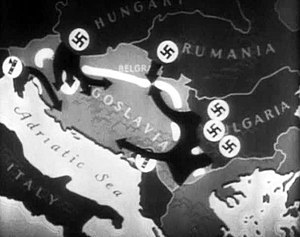
The Yugoslav order of battle before the invasion of Yugoslavia includes a listing (or order of battle) of all operational formations of the Royal Yugoslav Army (Serbo-Croatian Latin: Vojska Kraljevine Jugoslavije, VKJ), Royal Yugoslav Army Air Force (Serbo-Croatian Latin: Vazduhoplovstvo Vojske Kraljevine Jugoslavije, VVKJ) and Royal Yugoslav Navy (Serbo-Croatian Latin: Kraljevska Jugoslovenska Ratna Mornarica, KJRM) immediately prior to the World War II invasion of that country in April 1941.
The VKJ consisted of 33 divisions and a significant number of smaller formations, but due to tentative and incomplete mobilisation, only seven divisions and four smaller formations are known to have been at close to fighting strength and in their planned deployment locations when the German-led Axis assault commenced on 6 April 1941. The Yugoslav defence plan involved placing the bulk of its land forces close to its borders, with very limited strategic reserves in depth. Almost all of the divisions that had been effectively mobilised were concentrated in the 3rd Army Group deployed in the east of the country along the Romanian and Bulgarian borders between the Iron Gates and the Greek border. Most of the heavy weapons and armoured vehicles available to the VKJ were obsolete, most formations were heavily reliant on animal-powered transport, and the VKJ had only 50 tanks that could engage front line German tanks on an equal basis.
By 6 April 1941, the VVKJ had been almost completely mobilised, and consisted of four air brigades with more than 423 aircraft of Yugoslav, German, Italian, French, Czech and British design, including 107 modern fighter aircraft, and 100 modern medium bombers. Other than a small number of locally made Rogožarski IK-3 fighters, almost all the modern aircraft available to the VVKJ were of German, Italian or British design for which limited spares and munitions were available.
The KJRM consisted of a flotilla of river monitors based on the Danube and a small fleet based in several ports along the Adriatic coast. The blue-water navy centred on a flotilla leader, three smaller destroyers, four obsolescent submarines and a gunboat, supplemented by minelayers and torpedo boats. Some of the smaller vessels in the Yugoslav fleet had been inherited from the defeated Austro-Hungarian Empire following World War I and were obsolete.
© MMXXIII Rich X Search. We shall prevail. All rights reserved. Rich X Search
